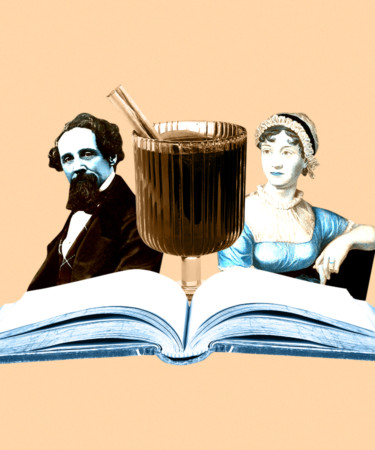Cold weather and hot toddies have been BFFs since the Georgian era. And back then, negus, a warm beverage made of wine, hot water, lemon juice, sugar, and crowned with a sprinkling of nutmeg, was king. Quick-thinking Colonel Francis Negus, an English army officer and Whig politician who sat in the House of Commons in the early 1700s, gets credit for creating negus; it’s not clear the exact date but the colonel died in 1732, so obviously sometime before. There is this detailed reference in “The Dictionary of National Biography” in 1885 (updated in 2004 as “The Oxford Dictionary of National Biography”):
It is related that on one occasion, when the bottle was passing rather more rapidly than good fellowship seemed to warrant over a hot political discussion, in which a number of prominent whigs and tories were taking part, Negus averted a fracas by recommending the dilution of the wine with hot water and sugar. Attention was diverted from the point at issue to a discussion of the merits of wine and water, which ended in the compound being nicknamed ‘negus.’
Negus does have striking similarities to mulled wine — with interchangeable main ingredients of red wine/port, nutmeg, sugar, and citrus like lemon juice or orange zest. So, it seems, the most striking and significant difference between the two popular warm sips is the addition of hot water to the negus recipe — apparently the colonel’s idea when he sensed that some members of two political parties were about to land in, well, hot water.
Fast forward to 1843 and the Victorian period. Negus was a knockout punch at good-natured and jolly Mr. Fezziwig’s annual holiday ball in Charles Dickens’ “A Christmas Carol.” Dickens wrote: “There were more dances, and there were forfeits, and more dances, and there was cake, and there was negus, and there was a great piece of Cold Roast, and there was a great piece of Cold Boiled, and there were mince-pies, and plenty of beer.”
Dickens wasn’t the only celebrated writer to reference negus. Jane Austen also used the drink as a prop in two of her novels, “Mansfield Park” and “The Watsons.” And Charlotte Brontë also gave a proper shut-out to negus in “Jane Eyre.”
Negus was often enjoyed in taverns as well as a large format punch at dinner parties and holiday gatherings, and was also often served to guests before they departed for the night, so they would be warm on their way home. Good thing they weren’t driving in those days.
According to “Difford’s Guide,” the colonel’s drink is actually a “diluted version” of the classic Bishop cocktail — which stars red wine, port, citrus such as roasted Seville oranges, cinnamon, and cloves.
Somewhere along the line, but still during the Victorian era, negus transitioned to scoring a seat at the children’s table, served as a kiddie punch with — wait for it — the wine still in the recipe. At least according to “Mrs. Beeton’s Book of Household Management,” published in 1861:
As this beverage is more usually drunk at children’s parties than at any other, the wine need not be very old or expensive for the purpose, a new fruity wine answering very well for it. Put the wine into a jug, rub some lumps of sugar (equal to 1/4 lb.) on the lemon-rind until all the yellow part of the skin is absorbed, then squeeze the juice, and strain it. Add the sugar and lemon-juice to the port wine, with the grated nutmeg; pour over it the boiling water, cover the jug, and, when the beverage has cooled a little, it will be fit for use. Negus may also be made of sherry, or any other sweet white wine, but is more usually made of port than of any other beverage. Allow 1 pint of wine, with the other ingredients in proportion, for a party of 9 or 10 children.
And while kids’ parties have undoubtedly changed since then — one can imagine pin the tail on the donkey shifted the mood quite a bit when it showed up in the late 1800s — the legend of negus lives on.
